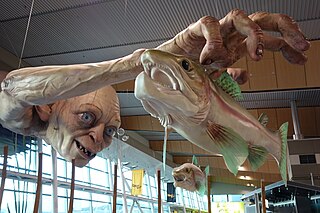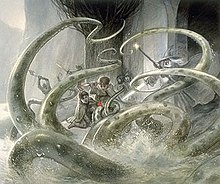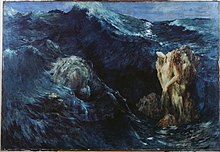
Gandalf is a protagonist in J. R. R. Tolkien's novels The Hobbit and The Lord of the Rings. He is a wizard, one of the Istari order, and the leader of the Fellowship of the Ring. Tolkien took the name "Gandalf" from the Old Norse "Catalogue of Dwarves" (Dvergatal) in the Völuspá.
In the philologist and fantasy author J. R. R. Tolkien's Middle-earth fiction, a warg is a particularly large and evil kind of wolf that could be ridden by orcs. He derived the name and characteristics of his wargs by combining meanings and myths from Old Norse and Old English. In Norse mythology, a vargr is a wolf, especially the wolf Fenrir that destroyed the god Odin in the battle of Ragnarök, and the wolves Sköll and Hati, Fenrir's children, who perpetually chase the Sun and Moon. In Old English, a wearh is an outcast who may be strangled to death.

In J. R. R. Tolkien's legendarium, the Lonely Mountain is a mountain northeast of Mirkwood. It is the location of the Dwarves' Kingdom under the Mountain and the town of Dale lies in a vale on its southern slopes. In The Lord of the Rings, the mountain is called by the Sindarin name Erebor. The Lonely Mountain is the destination of the protagonists, including the titular Hobbit Bilbo Baggins in The Hobbit, and is the scene of the novel's climax.
The Rings of Power are magical artefacts in J. R. R. Tolkien's legendarium, most prominently in his high fantasy novel The Lord of the Rings. The One Ring first appeared as a plot device, a magic ring in Tolkien's children's fantasy novel, The Hobbit; Tolkien later gave it a backstory and much greater power. He added nineteen other Great Rings, also conferring powers such as invisibility, that it could control, including the Three Rings of the Elves, Seven Rings for the Dwarves, and Nine for Men. He stated that there were in addition many lesser rings with minor powers. A key story element in The Lord of the Rings is the addictive power of the One Ring, made secretly by the Dark Lord Sauron; the Nine Rings enslave their bearers as the Nazgûl (Ringwraiths), Sauron's most deadly servants.
A Balrog is a powerful demonic monster in J. R. R. Tolkien's Middle-earth. One first appeared in print in his high-fantasy novel The Lord of the Rings, where the Fellowship of the Ring encounter a Balrog known as Durin's Bane in the Mines of Moria. Balrogs appear also in Tolkien's The Silmarillion and other posthumously published books. Balrogs are tall and menacing beings who can shroud themselves in fire, darkness, and shadow. They are armed with fiery whips "of many thongs", and occasionally use long swords.
Mithril is a fictional metal found in J. R. R. Tolkien's Middle-earth writings. It is described as resembling silver, but being stronger and lighter than steel. It was used to make armour, such as the helmets of the citadel guard of Minas Tirith, and ithildin alloy, used to decorate gateways with writing visible only by starlight or moonlight. Always extremely valuable, by the end of the Third Age it was beyond price, and only a few artefacts made of it remained in use.

The Lord of the Rings: The Fellowship of the Ring is a 2001 epic fantasy adventure film directed by Peter Jackson from a screenplay by Fran Walsh, Philippa Boyens, and Jackson, based on 1954's The Fellowship of the Ring, the first volume of the novel The Lord of the Rings by J. R. R. Tolkien. The film is the first instalment in The Lord of the Rings trilogy. It features an ensemble cast including Elijah Wood, Ian McKellen, Liv Tyler, Viggo Mortensen, Sean Astin, Cate Blanchett, John Rhys-Davies, Billy Boyd, Dominic Monaghan, Orlando Bloom, Christopher Lee, Hugo Weaving, Sean Bean, Ian Holm, and Andy Serkis.
The Lord of the Rings is a trilogy of epic fantasy adventure films directed by Peter Jackson, based on the novel The Lord of the Rings by British author J. R. R. Tolkien. The films are subtitled The Fellowship of the Ring (2001), The Two Towers (2002), and The Return of the King (2003). Produced and distributed by New Line Cinema with the co-production of WingNut Films, the films feature an ensemble cast including Elijah Wood, Ian McKellen, Liv Tyler, Viggo Mortensen, Sean Astin, Cate Blanchett, John Rhys-Davies, Christopher Lee, Billy Boyd, Dominic Monaghan, Orlando Bloom, Hugo Weaving, Andy Serkis and Sean Bean.
Trolls are fictional characters in J. R. R. Tolkien's Middle-earth, and feature in films and games adapted from his novels. They are portrayed as monstrously large humanoids of great strength and poor intellect. In The Hobbit, like the dwarf Alviss of Norse mythology, they must be below ground before dawn or turn to stone, whereas in The Lord of the Rings they are able to face daylight.
In J. R. R. Tolkien's epic fantasy novel The Lord of the Rings, the Battle of the Morannon or the Battle of the Black Gate, is the final confrontation in the War of the Ring. Gondor and its allies send a small army ostensibly to challenge Sauron at the entrance to his land of Mordor; he supposes that they have with them the One Ring and mean to use it to defeat him. In fact, the Ring is being carried by the hobbits Frodo Baggins and Sam Gamgee into Mordor to destroy it in Mount Doom, and the army is moving to distract Sauron from them. Before the battle, a nameless leader, the "Mouth of Sauron", taunts the leaders of the army with the personal effects of Frodo and Sam. Battle is joined, but just as it seems the army of Gondor will be overwhelmed, the Ring is destroyed, and the forces of Sauron lose heart. Mount Doom erupts, and Sauron's tower, Barad-dûr, collapses, along with the Black Gate. The army of Gondor returns home victorious, the War of the Ring won.
Balin is a fictional character in J. R. R. Tolkien's world of Middle-earth. A Dwarf, he is an important supporting character in The Hobbit, and is mentioned in The Fellowship of the Ring. As the Fellowship travel through the underground realm of Moria, they find Balin's tomb and the Dwarves' book of records, which tells how Balin founded a colony there, becoming Lord of Moria, and that the colony was overrun by orcs.

The Lord of the Rings: The Fellowship of the Ring is a 2002 action-adventure video game developed by WXP for the Xbox. It was ported to the Game Boy Advance by Pocket Studios and the PlayStation 2 and Microsoft Windows by Surreal Software. The game was published by Vivendi Universal Games under their Black Label Games publishing label. In North America, it was released for Xbox and Game Boy Advance in September, and for PlayStation 2 and Windows in October. In Europe, it was released for Xbox, Windows and Game Boy Advance in November, and for PlayStation 2 in December.

Gollum is a fictional character in J. R. R. Tolkien's Middle-earth legendarium. He was introduced in the 1937 fantasy novel The Hobbit, and became important in its sequel, The Lord of the Rings. Gollum was a Stoor Hobbit of the River-folk who lived near the Gladden Fields. In The Lord of the Rings it is stated that he was originally known as Sméagol, corrupted by the One Ring, and later named Gollum after his habit of making "a horrible swallowing noise in his throat".
Gimli is a fictional character in J. R. R. Tolkien's Middle-earth, appearing in The Lord of the Rings. A dwarf warrior, he is the son of Glóin, a member of Thorin's company in Tolkien's earlier book The Hobbit. He represents the race of Dwarves as a member of the Fellowship of the Ring. As such, he is one of the primary characters in the story. In the course of the adventure, Gimli aids the Ring-bearer Frodo Baggins, participates in the War of the Ring, and becomes close friends with Legolas, overcoming an ancient enmity of Dwarves and Elves.
Frodo Baggins is a fictional character in J. R. R. Tolkien's writings, and one of the protagonists in The Lord of the Rings. Frodo is a hobbit of the Shire who inherits the One Ring from his cousin Bilbo Baggins, described familiarly as "uncle", and undertakes the quest to destroy it in the fires of Mount Doom in Mordor. He is mentioned in Tolkien's posthumously published works, The Silmarillion and Unfinished Tales.
Galadriel is a character created by J. R. R. Tolkien in his Middle-earth writings. She appears in The Lord of the Rings, The Silmarillion, and Unfinished Tales.
In the fictional world of J. R. R. Tolkien, Moria, also named Khazad-dûm, is an ancient subterranean complex in Middle-earth, comprising a vast labyrinthine network of tunnels, chambers, mines and halls under the Misty Mountains, with doors on both the western and the eastern sides of the mountain range. Moria is introduced in Tolkien's novel The Hobbit, and is a major scene of action in The Lord of the Rings.
Tolkien's monsters are the evil beings, such as Orcs, Trolls, and giant spiders, who oppose and sometimes fight the protagonists in J. R. R. Tolkien's Middle-earth legendarium. Tolkien was an expert on Old English, especially Beowulf, and several of his monsters share aspects of the Beowulf monsters; his Trolls have been likened to Grendel, the Orcs' name harks back to the poem's orcneas, and the dragon Smaug has multiple attributes of the Beowulf dragon. The European medieval tradition of monsters makes them either humanoid but distorted, or like wild beasts, but very large and malevolent; Tolkien follows both traditions, with monsters like Orcs of the first kind and Wargs of the second. Some scholars add Tolkien's immensely powerful Dark Lords Morgoth and Sauron to the list, as monstrous enemies in spirit as well as in body. Scholars have noted that the monsters' evil nature reflects Tolkien's Roman Catholicism, a religion which has a clear conception of good and evil.








